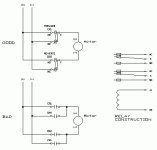If the picture above was unclear, maybe this one is better.
The point is to use inverting contact and not separate NO and NC
contacts from the same relay (see "construction detail" on the right)
Reason for suggestion is to overcome potentially wrong wiring
that could create intermittent short circuit with currents
exceeding normal levels by far (see BAD example). The "bad" example
can work but it's more delicate to control. Even if the coils
are interlocked using NC of other relay, you still can have short
circuit because of response time of the relay.
Contacts in series are used for high voltage. Contacts in parallel
for high currents. I never worked on cranes (like to stay on ground)
but I'm pretty sure that those DC motors aren't 12V.
I fail to see why clock signal needs to be as powerful as crane.
To get an accurate answer we need better question. All this is just
unnececary elaboration on vague question of someone who probably just
stopped by once, didn't bother to register and is unlikely to come again.
zzzzz







